8 Destroyers
![]()
![]()
![]()
![]()
The destroyers can destroy any element, unit or ore, except spaceships and their contents (turrets can be destroyed). The destroyers serve for destroying (yes it is!), capture, defend itself and push away the opponent.
There are four destroyer's types:
- Tanks,
- Big Tanks,
- Patrol Boats,
- Turrets (attached to spaceship).
8.1 Destruction
Destroying something require the fire of TWO detroyers.. A single destroyer can not destroy nor defend.
Any destruction costs 2 points: 1 point by fire.
Turret, tank and patrol boat can fire up to two cells of distance. A big tank can fire up to three cells of distance. A tank located on a mountain can (as a big tank) fire up to three cells (even on another mountain). The big tank, even carried, can never be on a mountain.
Between two turns, two tanks cannot stay side by side on mountains.
A destroyer can fire over any element or cell, including spaceship, mountain, ore, etc.
A destroyer can fire only twice per turn; these shots may be separated by any other actions. Every destroyer is resupplied in ammunitions at the end of the player's turn.
A destroyers cannot destroy their own units except pontoons (which are neutral).
Fire on a cell destroy all units on this cell. To destroy a barge it is enough to fire at one of both cells occupied (any one but the same one).
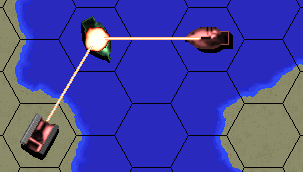
Red player destroy a green patrol boat.

Red player destroy a green barge.
Notice that the big tank fire at three cells of distance.
8.21 Under Opponent Fire
A cell is "under opponent fire" when it is under the croos fire of several destroyers of the same opponent.
A unit can never take place or move under the opponent fire. Only a destroyer can move under the opponent fire, and only in case of attack.

The colored cells are under the fire of both tanks.
We notice that more the destroyers are closer, more they are effective.
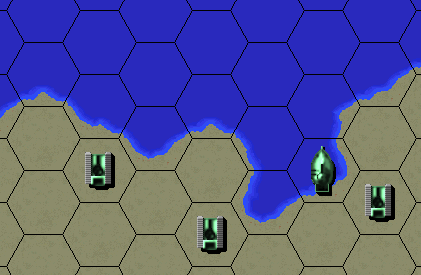 Aye Sir! The coast 116 is impregnable, Sir! I answer it! I locked everything! |
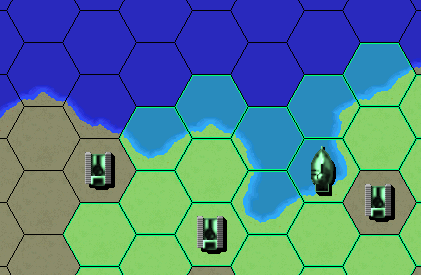 Sergeant, you are Full Metal Asshole! By looking at your zone of fire, it becomes evident that: |
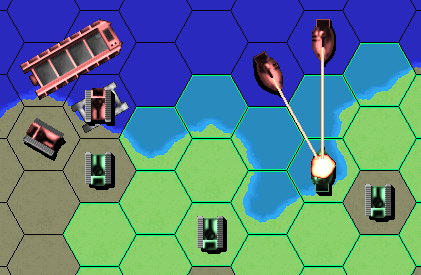 - With a pontoon and two tanks on a barge, the enemy can capture the tank on the left. - With two patrol boats, it will destroy your, annihilating your defence. Sergeant, you go to stay on the coast 116 there! - Sir! Yes Sir! |
8.3 Attak Under Opponent Fire
When a player attacks a sector defended by the opponent fire, his destroyers never arrive at the same time near the opponent. There is always the first one, then the second one.
The first one can never move under the opponent fire. He has to take place within fire range but outside the opponent fire.
The second can move to take place under the opponent fire. But it immediately has to stop and fire simultaneously with the first destroyer. Furthermore after this shot, the second destroyer shall not be any more under the opponent fire. In other words the shot has to target one of the opponent destroyers generating the zone of fire in which the second destroyer to penetrate.
In summary: the second destroyer can take place under the opponent fire, if its shot allows to annul the opponent fire zone, before all other movement.
If the second destroyer arrives transported towards a sector defended by an opponent fire, he must be unloaded on a cell out of opponent fire, and then move on the cell of shot.
All the attacks do not necessarily require to penetrate into a zone of opponent fire.
 |
Situation at the beginning of the turn. |
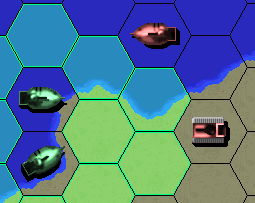 |
1st Point: The red patrol boat gets closer to be within fire range but stays outside the opponent fire. |
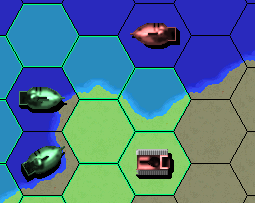 |
2nd Point: The red tank can penetrate into the zone of opponent fire because immediately... |
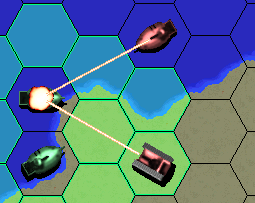 |
3rd And 4th Points: ... The red aggressors fire and destroy the green patrol boat. |
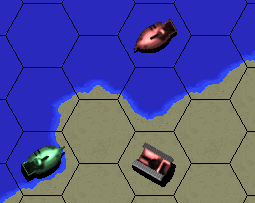 |
The green patrol boat remaining alone, the red tank is now outside the opponent fire. |
8.4 Capture
Two destroyers of the same player, at the touch of a unit of different colour, can make it change in their own colour.
This operation costs 1 point.
At the time of the capture, destroyers and target have to be outside the opponent fire. A player can thus protect a unit of the capture by sheltering it under his fire.
An captureed unit is at once useful for any action.
Even short of ammunitions, a destroyer can participate in an capture.
The contents of an captureed carrier also change colour, without spending of supplementary points.
When the destroyers are of different colours (it is possible after an capture of spaceship), the captureed unit takes one of both colours, in the choice of the player. The captureed unit is not necessarily an opponent unit, she just has to be of a different colour of at least one of the destroyers.
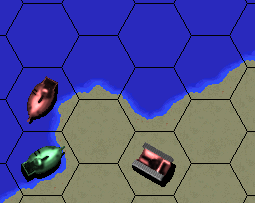 |
Continuation of the previous action... 5th And 6th Points: The red patrol boat gets closer to be at the touch of the green patrol boat. |
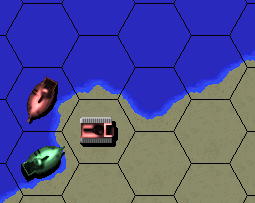 |
7th Point: The red tank gets closer to be also at the touch of the green patrol boat. |
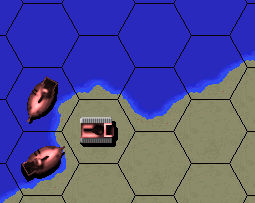 |
8th Point: The red tank and the patrol boat capture the green patrol boat which changes colour. |
Let us remind that it is not necessary to proceed to an capture to seize a pontoon.
The capture of spaceship is quite an other affair.
8.5 Neutralization
1) Implicit neutralization
When a unit is under the opponent fire it is said "neutralized".
A unit can remove its neutralization by moving back of a single cell if this movement puts it outside opponent fire. Otherwise, the unit can strictly make nothing. Then, only while reducing the opponent fire zone the player can remove neutralization of this unit.
A turret can not be neutralized, even under the fire, it can always fire.
A destroyer, even under the opponent fire, PARTICIPATED in the definition of the fire zones.
2) Explicit neutralization
After some manoeuvres, destroyers can have under their fire an opponent unit, without destroying it nor captureing it. The player can then decide to neutralize explicitly this unit.
A neutralizing destroyer has to remain immovable till the end of its turn, except when meanwhile his owner captures or destroys the neutralized unit. Although immovable, a neutralizing unit can fire, capture or neutralize.
A explicitly neutralized destroyer DOES NOT PARTICIPATE in the definition of the fire zones. A turret is not neutralizable.
The effect of the explicit neutralization lasts only during the turn of the player. At the end of the turn the neutralization becomes implicit.
The big difference between implicit and explicit neutralization, is that in this last case the neutralized destroyer DOES NOT PARTICIPATE in the definition of the fire zones.
Drill
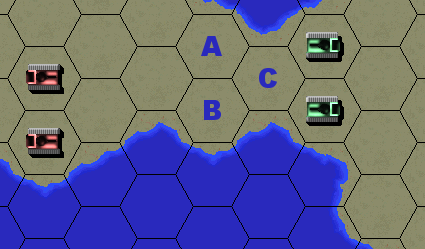 How are the red tanks going to proceed to destroy the green tanks? |
|
Solution: The first attacking red tank cannot take place A or B to be within fire range because the green tanks hold under their fire cells A, B and C. The red tanks thus have no means to destroy the green tanks. Naturally, you had found. Try at the moment with a big tank. |
| Continuation... |